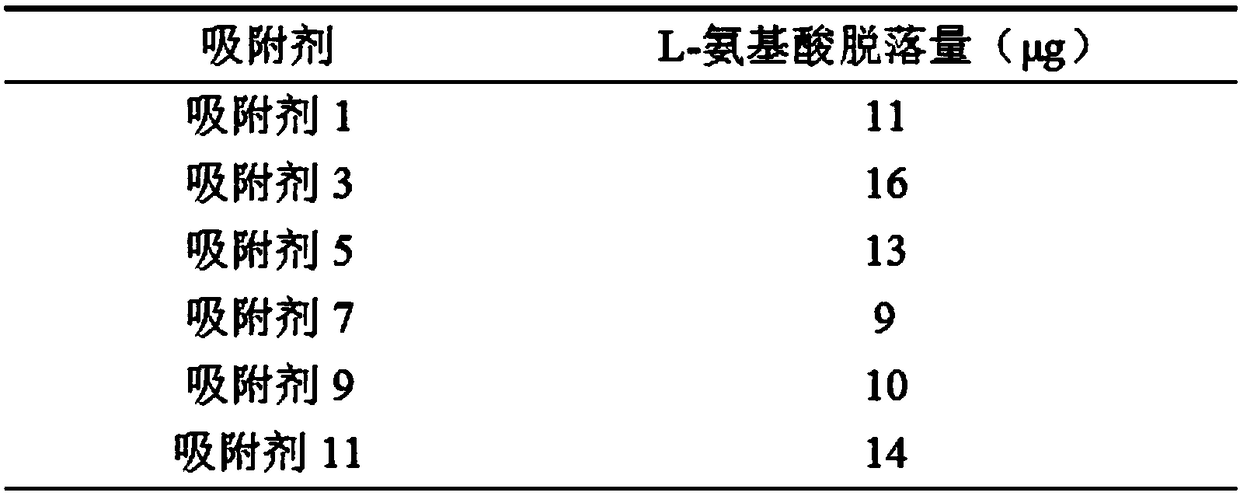Adsorbent for removing blood lipoprotein and preparation method thereof
A technology of lipoprotein and adsorbent, which is applied in the field of adsorbent for removing blood lipoprotein and its preparation, can solve the problems of insufficient application, high price, complicated operation, etc., and achieve improved adsorption effect, simple synthesis, and wide application prospects Effect
- Summary
- Abstract
- Description
- Claims
- Application Information
AI Technical Summary
Problems solved by technology
Method used
Image
Examples
preparation example Construction
[0031] A method for preparing an adsorbent for removing blood lipoproteins, comprising the steps of:
[0032] 1) Grafted side chain
[0033] Put 1-10ml of solid porous cellulose microspheres into a 50ml or 100ml three-necked flask, add 10-30ml of 50% ethanol solution and 0.01g-0.1g of ammonium cerium nitrate, trigger for 15min, then add 0.5g- 3g monomer p-allyloxybenzaldehyde or 4-(3-methyl-2-butenyloxy)benzaldehyde was stirred and reacted at 45°C-70°C for 2h-6h. After the reaction is complete, take it out for suction filtration, wash the unreacted monomer and initiator with distilled water, and then use acetone Soxhlet extraction to remove the homopolymer. The grafting rate of the reaction is between 0.05% and 5%.
[0034] 2) Immobilized amino acids
[0035] Place the porous microspheres prepared in step 1 in a 50ml or 100ml round bottom flask, add 10-100ml of absolute ethanol and 0.1-1g of L-amino acid (the mass ratio of acidic amino acid to hydrophobic amino acid is 1:1)...
Embodiment 1
[0038] Place 1ml of the solid porous cellulose microspheres in a 50ml three-neck flask, add 20ml of 50% ethanol solution and 0.01g of ammonium persulfate and initiate for 15min, then add 0.5g of monomer p-allyloxybenzaldehyde dropwise , The reaction was stirred at 50°C for 4h. After the reaction is complete, take it out for suction filtration, wash the unreacted monomer and initiator with distilled water, and then use acetone Soxhlet extraction to remove the homopolymer.
[0039] Place the porous microspheres prepared above in a 50ml round bottom flask, add 10ml of absolute ethanol, 0.1g of L-aspartic acid and 0.1g of L-valine, and add 2 drops of glacial acetic acid. The reaction was stirred at reflux for 15h. After the reaction is completed, it is washed with distilled water to obtain LDL adsorbent 1.
Embodiment example 2
[0041] Place 5ml of the solid porous cellulose microspheres in a 100ml three-necked flask, add 50ml of 50% ethanol solution and 0.05g of cerium ammonium nitrate to initiate 15min, then add dropwise 1.5g of monomer 4-(3-methyl- 2-butenyloxy)benzaldehyde, stirred at 60°C for 3h. After the reaction is complete, take it out for suction filtration, wash the unreacted monomer and initiator with distilled water, and then use acetone Soxhlet extraction to remove the homopolymer.
[0042] Place the porous microspheres prepared above in a 50ml round-bottomed flask, add 30ml of absolute ethanol, 0.5g L-glutamic acid and 0.25g L-leucine, and add 2 drops of glacial acetic acid. The reaction was stirred at reflux for 16h. After the reaction is completed, wash with distilled water to obtain LDL adsorbent 2.
PUM
| Property | Measurement | Unit |
|---|---|---|
| pore size | aaaaa | aaaaa |
Abstract
Description
Claims
Application Information
 Login to View More
Login to View More - R&D Engineer
- R&D Manager
- IP Professional
- Industry Leading Data Capabilities
- Powerful AI technology
- Patent DNA Extraction
Browse by: Latest US Patents, China's latest patents, Technical Efficacy Thesaurus, Application Domain, Technology Topic, Popular Technical Reports.
© 2024 PatSnap. All rights reserved.Legal|Privacy policy|Modern Slavery Act Transparency Statement|Sitemap|About US| Contact US: help@patsnap.com










